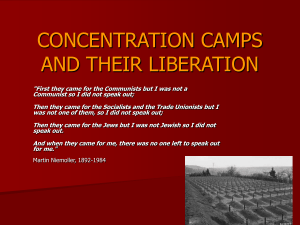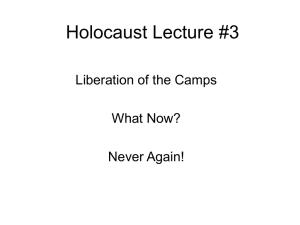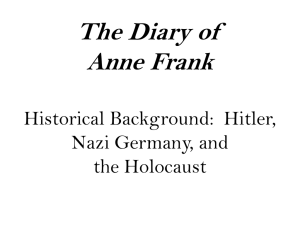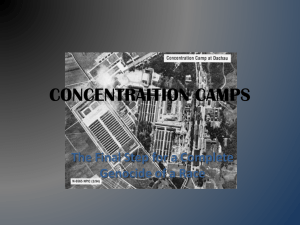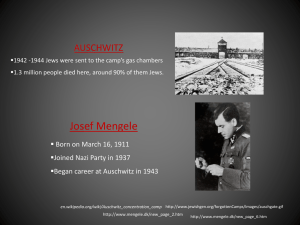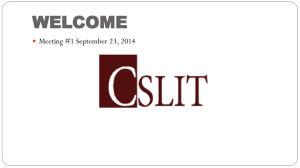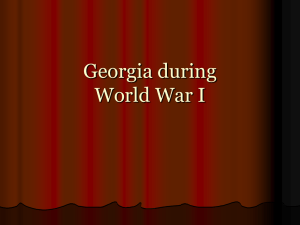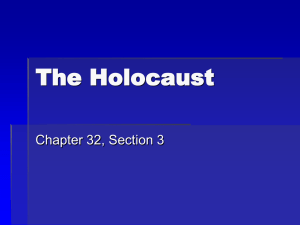The Camps - Freeman Public Schools
advertisement
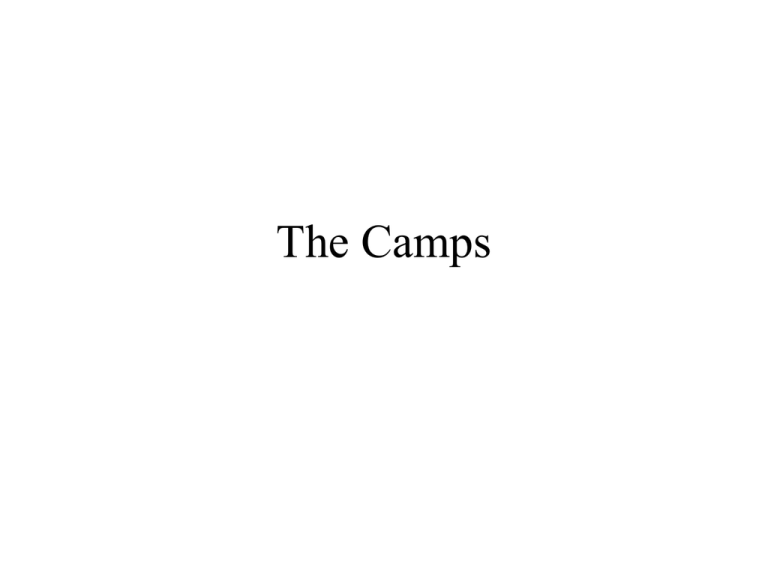
The Camps The Road To The Death Camps • When we hear the word Holocaust, it usually evokes visions of murder in gas chambers • It is true that many died this way, but it was not the original Nazi plan • The idea of death camps came about gradually The Road To Death Camps • Oct. 1939- Hitler signs order permitting physicians to put to death those unsuitable to live – “Life unworthy of life” – Backdates to Sept. 1, 1939 The Road To The Death Camps • T-4 Programs • First killings by starvation, then lethal injection, and later gassing Killing the Jews • Einsatzgruppen- mobile killing squads used in Russia – Helped by police battalions and Waffen SS units • Used trucks to move the older Jews Einsatzgruppen See historical footage and hear personal stories Einsatzgruppen • 3,000 men participated in the Einsatzgruppen – Officers of the units were ordinary citizens – Many were university educated • 1.2 million Jews killed one by one Euthanasia Program • They had gained experience with gassing victims in their Euthanasia Program • Physically eliminating persons considered unproductive or physically ill. Wansee Conference • Nazi leadership decided on the “Final Solution to the Jewish Problem” The Camp System • Between 1933 and 1945 Nazi Germany set up 20,000 camps • Dachau was the first camp • Used for many purposes – Forced labor – Transit camps – Extermination camps • All those imprisoned were physically concentrated in one area The Camp System • Concentration Camps – 1933-1939 – 1939-1942 – 1942-1945 Deportations • After Wannsee Conference, Jews were taken from the ghettos to death camps – Rode in cattle cars – Were told they were being relocated • Continued until the ghettos were “liquidated” The Extermination camps • Operation Reinhard- code name for the German plan to murder Jews in the Generalgouvernement • Killing centers or extermination camps were death factories – Six were established • First killing center was Chelmno The Extermination Camps • Sobibor was the second killing center – Jews deported from Lublin – Some 400 are selected to survive, temporarily, to provide manual labor for the killing center • Uprising October 14, 1943 – 300 prisoners escape, but 100 are recaptured and shot The Extermination camps • Treblinka – Treblinka I was a labor education camp for non-Jewish Poles who the Germans perceived as violating labor discipline. Most worked in a nearby gravel pit – Treblinka II-was the killing center • Ghettos of Warsaw and Radom • Some from Lublin and Theresienstadt The Extermination Camps – Treblinka II • Prisoners revolt on August 2, 1943 • During late July 1944, Soviet troops are moving into the area • Camp authorities and the Trawniki, trained guards, shot the remaining Jewish prisoners, between 300700, and hastily dismantled and evacuated the camp • Soviet troops overran the site of the labor camp and killing center in the last week of July 1944 The Extermination Camps • Belzec – Jews from Galicia, Lublin and Cracow sent here as well as hundreds of Poles and Gypsies (Roma and Sinti) – Unclear exactly how many perished here • Some Jews were murdered upon arrival without any record of their death – Only two known survivors of Belzec – Camp was dimantled and turned into a farm – Overran by the Soviets in July 1944 The Extermination Camps • Majdanek – Primarily served as a vast forced-labor camp – Was a transit camp for Polish and Soviet civilians being deported to the Reich for forced labor – Had three gas chambers – Was a storage facility for items taken from Jews The Extermination Camps • Majdanek – Nov. 3, 1943, Harvest Festival, special SS and police units dispatched to Lublin shot 18,000 Jews outside the camp • 8,000 were Majdanek prisoners • 11,000 were forced laborers from other camps • Music was played over loudspeakers to cover the sounds of mass murder • It was, in number of victims, the largest single-day, single-location killing during the Holocaust The Extermination Camps • Majdanek – Late July 1944, Soviets are approaching and SS had evacuated most of the prisoners to concentration camps further west – Soviets liberate July 24, 1944 • First camp to be liberated • Germans did not have time to dismantle the camp entirely and captured the camp virtually intact. Major Deportations Auschwitz-Birkenau • Auschwitz was the largest and most highly organized concentration and death camp – More people killed here than any other camp • Comprised 19 square miles and guarded by 4,500 • View animated map Auschwitz-Birkenau • Located in Polish town of Oswiecim • Was an Austrian military barrack and set up to incarcerate political prisoners Auschwitz -Birkenau • Auschwitz I – Was a concentration camp – Medical experiments were performed here • Auschwitz II – Also called Birkinau – Had the facilities for the killing center • Auschwitz III – Buna or Monowitz – Housed workers of the synthetic rubber plant Entrance to Auschwitz Entrance To Auschwitz The “Selection” • As trains arrived they were sorted into who would live and who would die – Call the selection The Selection The Bath Quote about the selection process • “The tattooing was not a pleasant experience, especially if you bear in mind how primitive the tool was with which it was carried out. Of course it hurt. There was blood and a nasty swelling afterwards. The shaving off of our hair was the most traumatic experience. It made me feel utterly vulnerable and reduced to a complete nobody. Quote about the selection process • I had relinquished my clothes as well, and I stood there stark naked, bald and with a number on my arm. In the space of a few minutes I had been stripped of every vestige of human dignity and become indistinguishable from everyone around me. – Anita, a holocaust survivor Shoes waiting to be processed by the sonderkommando Taken inside a huge glass case in the Auschwitz Museum. This represents one day's collection at the peak of the gassings, about twenty five thousand pairs. The Shoes • We are the shoes, We are the last witness. • We are shoes from grandchildren and grandfathers, • From Prague, Paris, and Amsterdam, • And because we are only made of fabric and leather • And not of blood and flesh, each one of us avoided the hellfire. – Moses Schulstein, Yiddish Poet Glasses Life in Auschwitz • People slept on planks of wood – Six on a plank • Had a variety of experiences Life in Auschwitz The Gas Chambers • The Nazis would force large groups of prisoners into small cement rooms and drop canisters of Zyklon B, or prussic acid, in its crystal form through small holes in the roof. • These gas chambers were sometimes disguised as showers or bathing houses. The SS would try and pack up to 2000 people into this gas chamber Dead Bodies Waiting To Be Processed Processing the Bodies • Specially selected Jews known as the sonderkommando were used to to remove the gold fillings and hair of people who had been gassed. • The Sonderkommando Jews were also forced to feed the dead bodies into the crematorium. The Ovens At Dachau Destruction Through Work This photo was taken by the Nazis to show just how you could quite literally work the fat of the Jews by feeding them 200 calories a day Destruction Through Work Same group of men six weeks later Children of Experiments Pressure Experiment Those who Knew • Why didn’t they say anything? Why Wasn’t Auschwitz Bombed • Jewish leaders, some organizations, and the U.S. War Refugee Board urged the Allies to intervene – At the very least, destroy the rail lines – All requests were denied Why Wasn’t Auschwitz Bombed • Not within range of Allied bombers? • Military resources could not be diverted from the war effort • It might provoke even more vindictive German actions Liberation The End Evil is when a few good men decide to do nothing.

